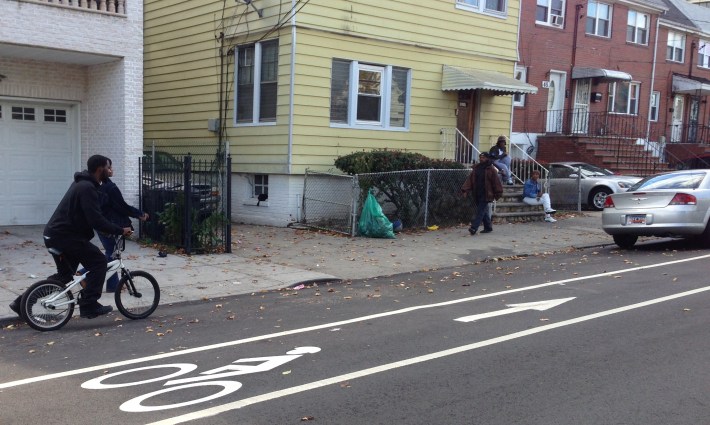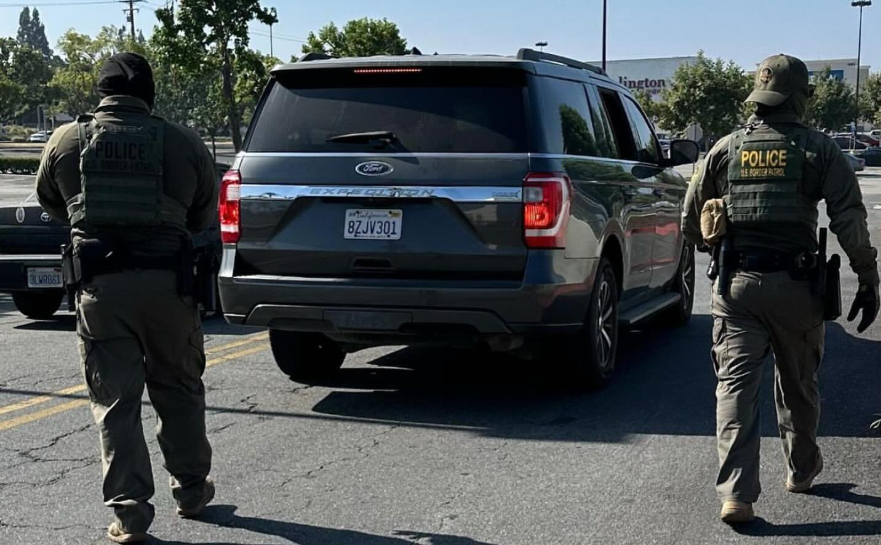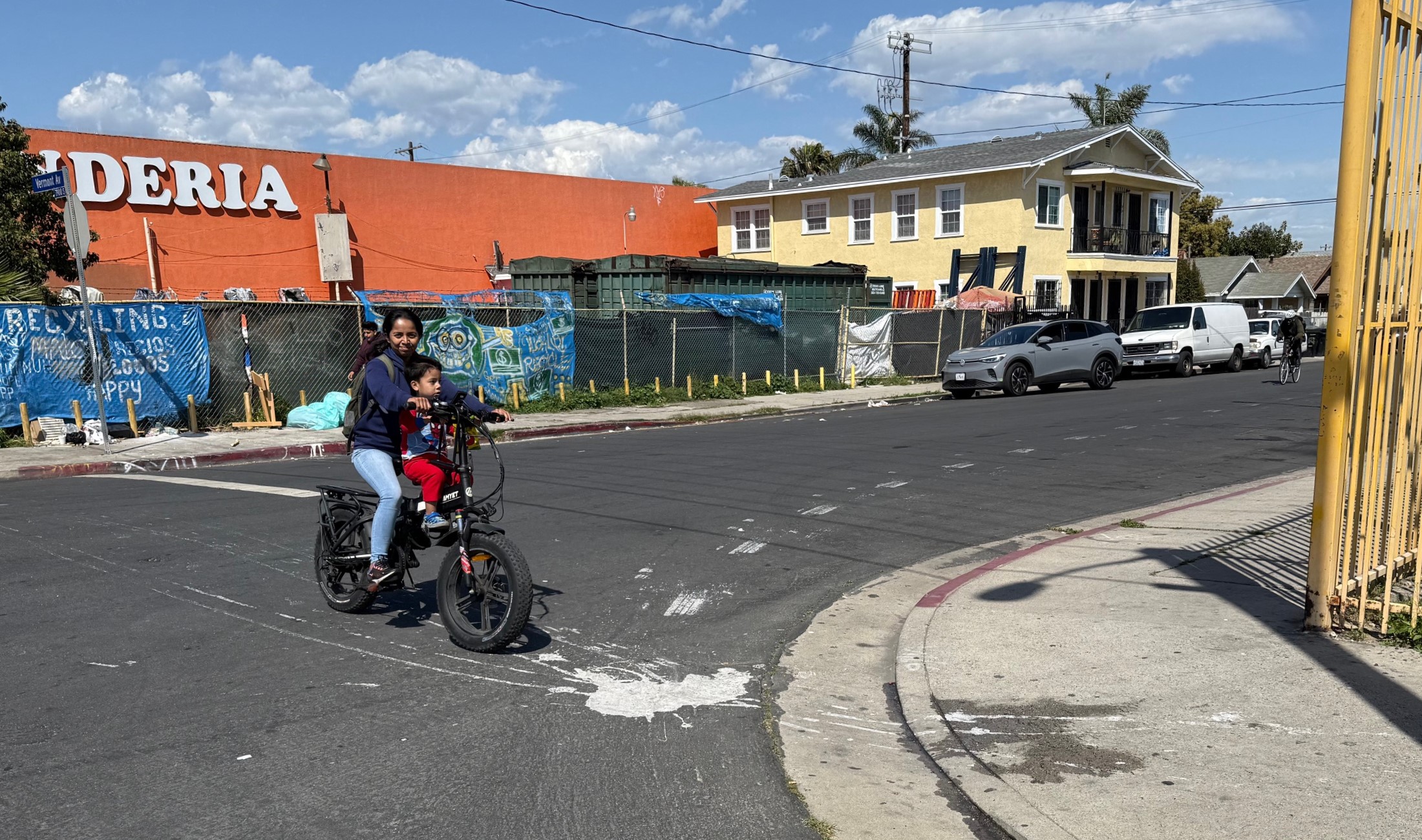(This is my fourth and probably, for now, last tale from the East Coast. We're nearly packed and I'll be in L.A. and writing real L.A. stories full-time starting next week. -Joe)

As I mentioned in the first installment of this series, I've been living in Jersey City, one subway stop from NYC. Jersey City is a sort of inner-ring suburb of NYC, but located in a different state. Jersey City is fairly population-dense, very walkable, and well-serviced by subway, bus, and light rail. For an L.A. County benchmark, Jersey City is roughly the same population as Glendale, in a bit smaller area. "JC" is a big city in its own right, but it's small in comparison to our taller neighbor across the Hudson River. Hence, I think that the Jersey City bikeway implementation story might be most applicable to L.A. County cities like Torrance, Pomona, Glendale, Pasadena and like. Good sized cities, but small in comparison to the city of Los Angeles.
When I moved here in 2012, Jersey City had two very short on-street bike lanes. One is 5-blocks long, painted as a sort of Earth Day 2012 publicity stunt. The other bike lane is even shorter; it's on a widened bridge in a state park.
The local bicycle advocates formed a non-profit, called BikeJC. BikeJC hosts rides, and pushes the city to do more for cycling. When I arrived, I got in touch with BikeJC and did some volunteering with them.
BikeJC leaders worked with the city to create a bicycle plan in 2006.
BikeJC leaders worked with the city to create another bicycle plan in 2010.
When, during election season in 2012, longtime Mayor Healy rolled out another bicycle plan, some BikeJC leaders were understandably discouraged. The mayor touted 55 miles of bikeways, lukewarmly declaring:
We’re obviously not going to put them [bikeways] in high-density traffic areas. But a lot of our side streets can accommodate bike lanes and we intend to do that.
The press quoted the 55 mile figure. The fine print, though, was that the city was committed to striping only the first 3 miles, which would be done the summer after the 2013 election. Like many bike plans, there was little political will, no timeline, and little confidence that implementation would actually happen.
Then longtime Mayor Healy lost an election.
The new mayor, Stephen Fulop, is a cyclist and triathlete. He's young and progressive. He could have easily called for another planning process. Under some urging from BikeJC, Fulop looked into his predecessor's 2012 bike plan. Fulop made good on his predecessor's promise; Jersey City striped most of the pledged initial 3 miles in September 2013.
Perhaps inspired by popular bike facility progress in adjacent Hoboken and nearby NYC, Fulop asked how much it would cost to implement all 55 miles in the 2012 bike plan. Paint is cheap. Turns out it would be just over a half-million dollars. That's a lot for you and me, but it's a small enough amount that it can be found in the city budget, without needing to apply for outside funding. Fulop identified unspent capital funding, put the project out to bid, and contracted for the entire network. The contractor is now under contract to install all 55 miles - 35 miles of bike lane, 20 miles of sharrows - by the summer of 2014.
The Jersey City story isn't on par with the NYC Janette Sadik-Khan streets transformation. These are basic bike lanes, not protected bike lanes or bicycle boulevards or anything out of the ordinary. They're really the low-hanging fruit. They represent the majority of the bike lane mileage that makes sense and that can be done without taking away car lanes or car parking. Nonetheless, it's a big leap from basically no on-street facilities to more than 50 miles in just one year. According to Fulop's office, it will give Jersey City the most on-street bikeway miles of any city in the state of New Jersey.
And that's not all. Fulop was inspired by the success of NYC's Citibike bike share system, and Jersey City worked with adjacent municipalities to release a bike share RFP. Bike share is anticipated to be implemented this summer.
I think that there's a lesson here for Southern California bicycle advocates.
Southern California seen numerous long bicycle plan processes resulting in good but, generally, compromised least-common-denominator plans. The bike plans then mostly sit on shelves while implementation drags out at a snail's pace. We get the impression that we'll never see most of the facilities approved in the plan.
The Jersey City story says that things can happen fast.
Well, fast - after many years of advocacy.
A change of leadership occurs, perhaps a mayor, councilmember, or city manager, and then things really move. I think it's somewhat similar to the fairly rapid livability changes in Long Beach, CA. It could be other changes - such as a spike in gas prices, or a high-profile car collision, or who, knows.
Street transformation can occur quickly, so, my advice to livability advocates is to stay on top of things and be ready for rapid change. Slog through those planning processes. Make sure that electeds and civil servants know that we're not going away. And... just when you think that things might have stalled, the landscape changes, an opportunities arise, and we see big changes. Keep up the good work!






